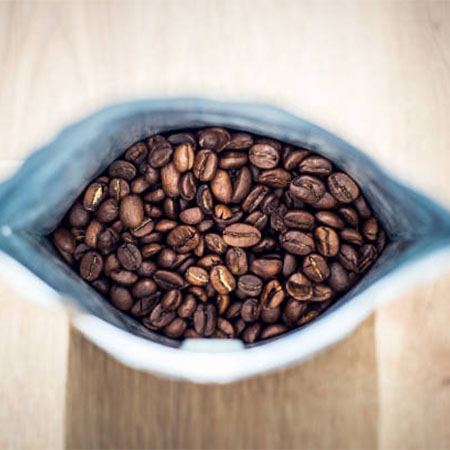Zipper coffee bags can be made from a variety of materials depending on the specific needs and preferences of the coffee business. In addition to traditional materials, you can also design your zipper coffee bags utilizing compostable materials and recycled materials. Different materials have their benefits and feathers. The material of all our zipper coffee bags are high barrier, food safe and can be applied to all kinds of dry food.
Traditional materials: PET/PE PET/VMPET/PE PET/AL/PE OPP/CPP NY/PE PET/NY/PE PET/NY/AL/PE Matt OPP/Kraft Paper/PE | Compostable materials: NK/PBS NK/PBAT NK/Kraft Paper/PBAT NK/Kraft Paper/NKME/PBAT Kraft Paper/PBAT Kraft Paper/NK/PBAT NK/Kraft Paper/PBS NK/NKME/PBS | Recyclable materials: Green PE/EVOH PE PE/EVOH PE Green PE/Green PE EVOH PE EVOH/PCR PE MDO PE/Green PE |
Link to learn more about our Quality Control of our zipper coffee bags |
Link to learn more about our Materials for Compostable Coffee Bags |
Link to learn more about our Materials for Recyclable Coffee Bags |
Below are the details of the common materials for zipper coffee bags.
Polyethylene (PE): Polyethylene is a lightweight and flexible plastic material that is commonly used for zipper coffee bags. It provides a good barrier to moisture, gases, and odors, helping to preserve the freshness and flavor of the coffee.
Polypropylene (PP): Polypropylene is another type of plastic material that is commonly used for coffee zipper bags. It is a strong and durable material that can withstand high temperatures, making it suitable for coffee packaging.
PET (Polyethylene terephthalate): PET is a clear, strong, and lightweight plastic material that is commonly used for zipper coffee bags. It is an excellent barrier to moisture, oxygen, and gases, helping to preserve the quality of the coffee.
Foil-lined materials: Foil-lined materials such as foil-lined kraft paper or foil-lined plastic are also commonly used for zipper coffee bags. The foil layer provides an additional barrier to moisture, oxygen, and light, helping to preserve the freshness and quality of the coffee.
PLA (polylactic acid): PLA can also be used for zipper coffee bags. It is biodegradable and compostable. And it is a biodegradable thermoplastic polyester derived from renewable resources such as corn starch or sugarcane. It is often used as a sustainable alternative to traditional petroleum-based plastics.
 Click to learn about MSTPACK factory |  Click to learn more about types of zipper coffee bags |
Starch-based materials can also be used to make zipper coffee bags, as they are another type of biodegradable and compostable material. Starch-based materials are often made from renewable sources such as corn, potato, or tapioca, and can be used to make a variety of packaging products, including zipper coffee bags.
NK (Cellulose films): NK is cellulose film. These films are made from renewable resources, such as wood pulp or other plant-based materials, and are fully biodegradable and compostable under the right conditions.
PBAT (Polybutylene Adipate Terephthalate): PBAT is a biodegradable and compostable polyester polymer. PBAT is made from a combination of adipic acid, terephthalic acid, and butanediol, and it can be produced using renewable resources, such as plant-based feedstocks, to make it more sustainable.
Kraft Paper: Kraft paper is made from wood pulp that has been chemically treated to improve its strength and durability. The resulting paper is brown in color and has a natural, organic look that is often associated with environmentally friendly products.
PBS (polybutylene succinate): PBS is a biodegradable polyester that is often used to make packaging materials, including coffee bags with zipper. PBS is derived from renewable resources such as corn starch, and it has good mechanical and barrier properties that make it suitable for packaging applications.

Click for a quote of zipper coffee bags
Green PE, also known as bio-based polyethylene, is made from sugarcane ethanol, a renewable and sustainable resource. It has the same properties as traditional polyethylene but is made from a renewable resource, making it a more sustainable option.
EVOH PE, or ethylene vinyl alcohol copolymer, is a high barrier material that is commonly used in food packaging to provide excellent oxygen and moisture barrier properties, preventing spoilage and extending the shelf life of the product.
HDPE (High-Density Polyethylene): HDPE is a commonly recycled plastic that is lightweight, strong, and resistant to moisture and chemicals.
MDO PE (Machine Direction Oriented Polyethylene): MDO PE is a type of polyethylene film that has been stretched in the machine direction during the manufacturing process to improve its properties. It is commonly used in packaging applications, such as bags, pouches, and labels, for food and consumer goods.
Overall, the choice of material for zipper coffee bags will depend on factors such as the desired level of durability, barrier properties, eco-friendliness, and functionality. By choosing the right material, coffee businesses can create packaging that is not only attractive and functional but also sustainable and environmentally responsible. Link BIO to star your custom zipper coffee bags projects.